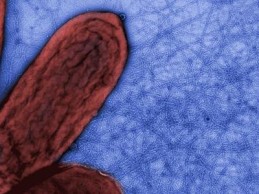Bacteria-produced nanowires can act like a biological transistor
August 15, 2011

A transmission electron micrograph of Geobacter sulfurreducens cells synthesizing a network of protein nanofilaments that exhibit metallic-like conductivity (credit: Anna Klimes and Ernie Carbone, UMass Amherst)
A fundamental, previously unknown property of microbial nanowires in the bacterium Geobacter sulfurreducens that allows electron transport across long distances has been discovered by a team of physicists and microbiologists at the University of Massachusetts Amherst.
The researchers said that this is the first time metallic-like conduction of electrical charge along a protein filament has been observed.
In the laboratory, Geobacter will grow on electrodes, producing thick, electrically conductive biofilms. In a series of studies with genetically modified strains, the researchers found the metallic-like conductivity in the biofilm could be attributed to a network of nanowires spreading throughout the biofilm.
These special structures are tunable in a way not seen before, the researchers found. Artificial nanowire properties can be changed by altering their surroundings. Geobacter’s natural approach is unique in allowing scientists to manipulate conducting properties by simply changing the temperature or regulating gene expression to create a new strain, for example.
The researchers said that by introducing a third electrode, a biofilm can act like a biological transistor, able to be switched on or off by applying a voltage. Their findings may one day lead to cheaper, nontoxic nanomaterials for biosensors and solid state electronics that interface with biological systems, they added.
Ref.: Nikhil S. Malvankar, et al., Tunable metallic-like conductivity in microbial nanowire networks, Nature Nanotechnology, 2011; [DOI: 10.1038/nnano.2011.119]